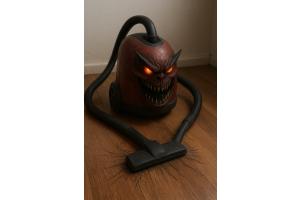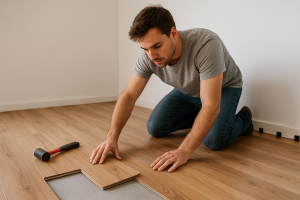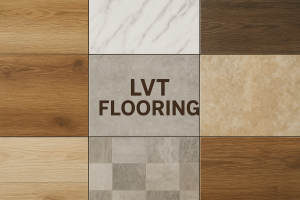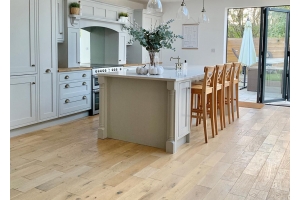
TL;DR
✅ Waterproof Confidence – Yes, you can put it in kitchens, bathrooms, laundry rooms — anywhere water might make an unwelcome appearance.
✅ Comfort Underfoot – Unlike stone or ceramic, LVT has a little give, meaning no icy shock in winter or aching feet after standing too long.
✅ Easy Installation – Click-lock systems mean you don’t need a degree in joinery to lay it yourself. Even glue-down options are straightforward.
✅ Low Maintenance – Sweep, mop, repeat. No waxing, sanding, or expensive treatments.
✅ Realistic Aesthetics – Modern print technology means you get knots, grains, and textures that could fool a lumberjack.
If you’ve been poking around Google seeking a definite definition about LVT flooring, or simply hunting down the best luxury vinyl tile, then congratulations - you’re in the right digital living room. Welcome!
So, let’s ditch the overly flowery introduction and get straight to it. Luxury Vinyl Tile (or LVT, if you’re short on syllables) is the flooring world’s quiet overachiever. It looks like the real deal — hardwood, stone, even ceramic — but without the price tag, installation headache, or heartache when you spill something or the pet does something unmentionable that causes your children to scream for a fortnight.
In this guide, we’ll demystify LVT, walk you through why it’s not just vinyl from the ’70s with a marketing glow-up, and explain why Direct Wood Flooring is the best place to get it without needing to remortgage your kidneys or sell a kidney.
What Is LVT Flooring?
This is the boring bit, right?
Luxury Vinyl Tile is the flooring equivalent of that person who can pull off both a tuxedo and jogging trousers. It’s versatility in spades. It’s a multi-layered product designed to mimic natural materials. Thing is, it’s so convincing that you’ll find yourself tapping it with your toe just to check it’s not actual oak.
Still boring? Time to announce what you’ve got under your feet.
First is the wear layer. This is a clear, tough topcoat that remains resistant to dents, scratches, and life’s general wear and tear. Next is the printed design layer, where a high-definition rendering gives you either wood grain, marble veining, or whatever aesthetic makes your floor feel like home.
That sits atop the core later, either flexible or rigid, which gives the floor its’ needed stability for a solid foundation. Beneath that is the necessary backing layer, which is effectively a moisture-resistant base that helps prevent damp and warping.
The key takeaway? LVT is far from linoleum’s sad cousin. It’s engineered to look gorgeous, survive family life, and do it all at a price that leaves room in your budget for matching curtains.
Not so boring now, are we?
LVT vs Laminate vs Hardwood
If floors were judged by merit, then LVT would win on versatility, hardwood on prestige, and laminate on budget friendly aspects.
LVT strikes the perfect harmony for those that require quality but don’t have millions to spend on something the children will slowly destroy until those teenage years bring a different kind of mayhem.
Hardwood is beautiful, sure, but expensive. Also, not a fan of moisture, which means kitchens, bathrooms, and basements are dicey. House parties are also a no-no, unless your idea of a good time revolves around Earl Grey and Lemon Drizzle Cake. Even then, perfumed tea can act like napalm upon hardwood floors should the soiree turn into a Rolling Stones gig.
Laminate, on the other hand, is always up for the challenge. Affordable and durable, yes, but water is also its’ Achillies heel. Got a toddler that enjoys catapulting various fluids from the kitchen table? You’ll have the joy of stains to remind you forever more about the dangers of mixing milk and sweetcorn.
This is where LVT comes in. Nearly waterproof, scratch-resistant, soft on bare feet, and it won’t sulk if you drop a saucepan on it.
The real magic is that LVT gives you the visual prestige of hardwood or stone but with durability that suits real life. The kind with one friend who insists on wearing stilettos indoors, while bringing a suitcase with stands made of razorblades.
And, without proclaiming ourselves to be superheros, Direct Wood Flooring sweeps in like the champion of a budget-conscious happy ending. Our LVT range has that high-end look without the high-end markup, so you can get your dream floor and still have cash left over for, say, a holiday or twelve.
How to choose the right LVT for your home
Alright, you’re sold on the concept. Now comes the fun part - choosing your perfect floor. This is where some people make mistakes, like picking a shade that looks dreamy in the showroom but turns their living room into a cave.
- Match Style to Lifestyle – Got pets? Kids? A clumsy spouse? Go for a thicker wear layer (0.5mm or more) for maximum durability.
- Consider Room Lighting – Dark LVT can look sleek, but in small or dim rooms, it can make things feel smaller. Lighter tones bounce light and make rooms airier.
- Think About Texture – Smooth LVT is sleek but can be slippery; textured finishes give more grip and a more authentic “real wood” feel.
- Waterproof vs Water-Resistant – If you’re installing in a bathroom, don’t just settle for “water-resistant.” Go fully waterproof.
- Buy from a Trusted Retailer – Which is me saying, politely but firmly, that you should be browsing Direct Wood Flooring. Not only do they have an obscene number of styles, but they also have helpful guides, free samples, and prices that make competitors break out in a cold sweat.
LVT is the smart flooring choice
In a world where hardwood gets all the glory and laminate shouts about affordability, LVT combines both. For beauty and practicality, it doesn’t get any better. The best part is, it does it without needing constant maintenance or a climate-controlled environment.
We’ve mastered the art of high-end flooring without the high-end price, even if we do say so ourselves; which means your floors can look like a million pounds without costing anywhere near it. You can thank us later.












